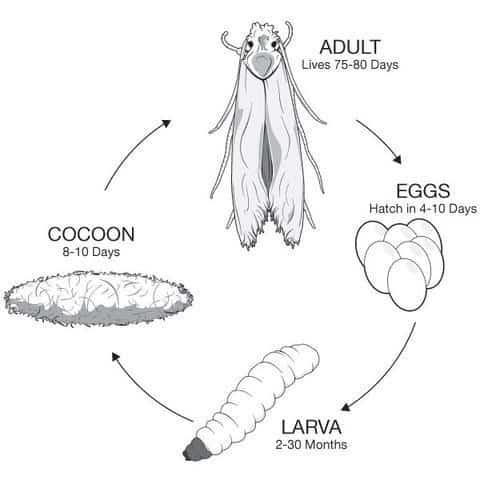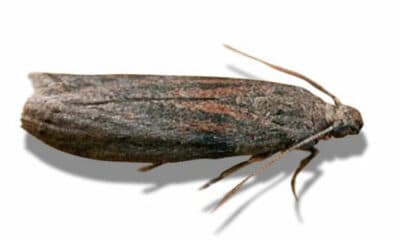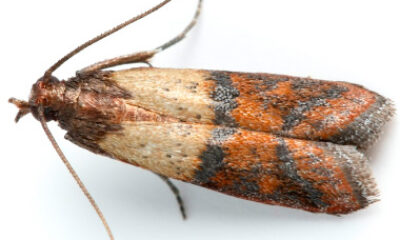
Stored Product Insects or ( SPI ) for short The main reason we control SPIs is the incredible damage and contamination they cause to foodstuffs, raw materials and finished products. SPIs not only eat these products, they breed in them and can spread quickly, contaminating a huge amount of product which is then unfit for human consumption. Contamination of foodstuffs is such a huge concern that there is an entire branch of forensic entomology dedicated to studying it. You can identify if you have a problem by using some of our bullet points below.
 Discoloration of food products, such as flour
Discoloration of food products, such as flour
 Damage to raw materials, tainting
Damage to raw materials, tainting
 Small holes in nuts or grains
Small holes in nuts or grains
 Live or dead insects, larvae, pupae or silken webbing
Live or dead insects, larvae, pupae or silken webbing
 Track marks in powder, flour or grain
Track marks in powder, flour or grain

STORED PRODUCT INSECTS - MOTHS
The Mill Moth ( Ephestia Kuehniella )
A major pest of flour mills, its main habitats are flour and grout mills, corn milling plants, bakeries and any other place used for processing grains or preparing flour products.
Adults are short lived (approximately 14 days), do not feed and usually fly near the roofings. They fly more actively at the early morning and late afternoon.
Mill moth larvae prefer wheat flour, but will also feed on all sorts of grains, cereals, seeds, macaroni, dried fruits, cocoa, nuts and almonds.
Control Methods
The treatment is as for all stored product pests, scrupulous housekeeping, regular pest control inspections which give detailed feed-back, so that any problems can be spotted early and dealt with.
Give us a call to sort any stored product infestations, use our contacts page.

Tropical Warehouse Moth ( Ephestia Cautella )
The tropical warehouse moth has brown-grey forewings with a darker band running across the middle and far edges. The wings also have a fringe of hair.The wingspan is approximately 15 – 20 mm and when at rest its length is between 10 – 12 mm. The yellow-white larvae grow up to 14 mm long, have a brown head and a dark spot at the base of the back hairs..
Life Cycle
Females lay between 100 – 200 eggs among or in the infested goods. The eggs hatch in around 4 – 8 days and begin to spin immediately. The larva pupates in a cocoon either within or around the infested material. Normally about 80 days is required from egg to adult however the life cycle can be completed in as few as 60 days.
Damage
The tropical warehouse moth occurs both in tropical and temperate regions and commonly attacks grains, nuts, dried fruits and a great variety of other stored products. The adult moths dart about as they fly, and are mostly seen at dawn and dusk.

Warehouse Moth ( Ephestia Elutella )
The Warehouse moth is a popular industrial pest, which infests both food products (flours, cereals, cocoa, etc…) and tobacco. It is grey-brown in colour and is banded with lighter and darker colours on its wings. The length of this moth is 7 mm to 9 mm at rest and 10 mm to 16 mm with spread wings. The larvae may be slightly different in colour, depending on their diet – off-white, yellowish or reddish colour.
Life Cycle
The adult female Warehouse moth can lay up to 279 eggs. In temperatures above 20 degrees Celsius it takes 3 to 6 days for the eggs to hatch and it them takes 10 to 20 days for the pupae to mature. The total lifespan of the Warehouse moth is between 50 and 90 days, depending on the conditions available.
Signs
The signs of Warehouse moth infestation are silk webs over the infested products, as well as damaged nuts and grains and solid lumps within the flours. The presence of the adult moths, which can usually be spotted at night around the roof of the building, as well as the larvae that feed on the products, which can be spotted inside or crawling around the stored products.

Indian Meal Moth ( Plodia Interpunctella )
The Indian Meal Moth is a very common household pest, feeding principally on stored food products. In fact, it has been called the most important pest of stored products commonly found in homes and grocery stores. The larvae are general feeders and can be found in grain products, seeds, dried fruit, dog food, and spices. The species was named after being noted for feeding on Indian-meal or cornmeal and it does not occur natively in India as the aberrant usage of Indian meal moth would suggest.
Adults are 8–10 mm in length with 16–20 mm wingspans. The distal two thirds of their forewings are generally reddish brown in color with a copper luster. They can also be bronze or dark gray. The more proximal parts of the wings are yellow-gray or white-gray, with a dark band at the intersection between the proximal and distal regions. The hindwings, in general, are uniformly gray.
The eggs of the Indian-meal moth are white, ovate, and very small. It is difficult to see them with the naked eye. Newly-hatched larvae are equally difficult to see. They are mostly off-white in color, have brown heads, and develop through five to seven larval instars. When these larvae mature, they measure about 12–14 mm long. Larvae also have three sets of legs near the head and five sets of prolegs protruding from the abdomen. The legs help the larvae move over long distances in order to find pupation sites.
Life Cycle
Usually the life cycle of an Indian-meal moth colony starts in a location where grain is present. Larvae begin to hatch in approximately two to fourteen days. Fully-grown larvae are able to spin webs and leave silk threads in their path of travel. Mature larvae that make silk also make threaded cocoons. The pupae are often seen on grain surfaces and on the walls of grain bins. The adults emerge in four to ten days. They then mate and the cycle begins again. The entire life cycle of this species ranges between 30 to 300 days. A typical life cycle is 50 days. Under optimal conditions a life cycle can be as short as 28 days but cooler winter months prohibit this. Seven to nine generations of moths can live in a year.
Control Methods
The treatment is as for all stored product pests, scrupulous housekeeping, regular pest control inspections which give detailed feed-back, so that any problems can be spotted early and dealt with.
Whether in a commercial or domestic setting, Environmental Pest Solutions can assist you in completely ridding your property of any type of Moth. Our expert team will work quickly and efficiently to remove the problem with minimal disruption.
